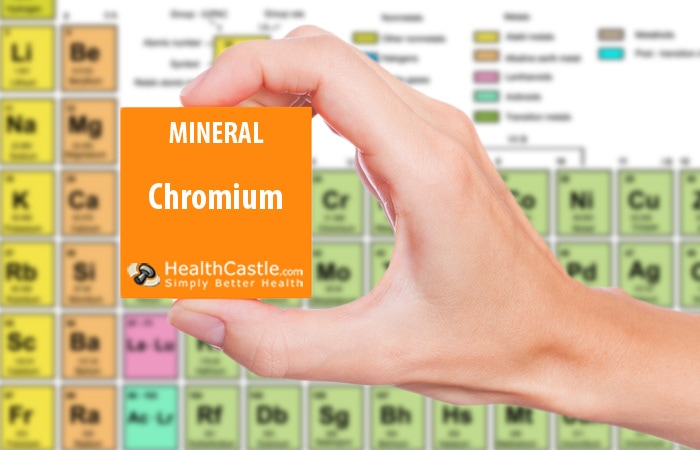
Written By: Carolyn Berry, RD
Title: Registered Dietitian
Alumni: University of British Columbia
Last Updated on:

Chromium is a metal. It is known as an essential trace mineral because very small amounts of chromium are necessary for human health. It is interesting to note that the chromium in our bodies is the same metal used in the chrome plating for cars.
Table of Contents
The Dietary Reference Intakes (DRI) for chromium are shown below:
| Age Group | Recommended Dietary Allowance (RDA) per Day1 | Tolerable Upper Intake Level (UL) per Day2 |
| Adults | ||
| 19 to 50 years | 35 mcg males 25 mcg females | *No upper limit is established for this nutrient |
| 51 years and up | 30 mcg men 20 mcg women | |
| Kids and Youth | ||
| 1 to 3 years | 11 mcg | |
| 4 to 8 years | 15 mcg | |
| 9 to 13 years | 25 mcg boys 21 mcg girls | |
| 14 to 18 | 35 mcg men 24 mcg women | |
| Special Considerations | ||
| Pregnant women 14 to 18 years | 29 mcg | |
| Pregnant women 19 years and up | 30 mcg | |
| Lactating women 14 to 18 years | 44 mcg | |
| Lactating women 19 years and up | 45 mcg |
Excessive intake of chromium-containing foods has not shown to be toxic to humans because of chromium’s low absorption rates and high excretion rates.

One of chromium’s main roles is to maintain normal blood sugar levels3. It does this by increasing the effectiveness of insulin as component of glucose tolerance factor (GTF). The primary function of GTF is to increase the action of insulin. Insulin is the hormone responsible for carrying sugar (glucose) into the cells, where it can be used for energy. After a meal, glucose levels rise in the blood and need to be let into the cells. Insulin is able to make this happen through the action of GTF.
Research indicates that there is some evidence to show that chromium supplements may help people with diabetes lower blood sugar levels.
Another important function of chromium is its role in metabolism. Chromium participates in cholesterol metabolism, helping to maintain normal blood cholesterol levels4. In addition, chromium is involved in nucleic acid metabolism. Nucleic acids are the building blocks of DNA, the genetic material found in every cell.
It is rare to be deficient in chromium. Deficiency sometimes occurs in elderly people with type 2 diabetes and in infants with protein-calorie malnutrition. Low chromium levels can increase blood sugar, triglycerides, and cholesterol levels, and increase the risk for diabetes and heart disease.
Chromium occurs naturally in a wide variety of foods; however, many foods contain only 1 or 2 mcg of chromium per serving. In addition, food processing methods often remove the naturally occurring chromium. Nutrient databases do not contain data for the chromium content of foods.
Food sources of chromium include meat (especially liver), peas, beans, cheese, whole grains, brewer’s yeast, and red wine. Brewer’s yeast, particularly when grown in chromium-rich soil, is a very rich dietary source of chromium.
In the United States: The % daily value gives you an idea of how much chromium is in the food you eat. The daily value for chromium is 35 mcg5, which is much higher than the DRI for all age groups. It is unclear why the daily value is so high; it may have been established a long time ago and therefore may need to be updated. The FDA does not require that the % daily value for chromium be listed on the Nutrition Facts label.
In Canada: The daily value for chromium is 35 mcg6, which again is much higher than the DRI for all age groups. Listing the daily value for chromium on the Nutrition Facts label is optional.
Iron: Excessive supplementation of chromium can make it difficult for the body to use iron, which could lead to iron deficiency.
Vitamin C: Vitamin C may help with the absorption of chromium.
Zinc: Taking zinc and chromium together may decrease absorption of both minerals.
HealthCastle has strict sourcing guidelines. We reference peer-reviewed studies, scientific journals and associations. We only use quality, credible sources to ensure content accuracy and integrity.
Alumni: University of British Columbia – Carolyn Berry is a Vancouver-based Registered Dietitian, self-proclaimed foodie, marathon runner, and owner of Berry Nourished. Carolyn works in a variety of areas including clinical nutrition, outpatient counselling at Medisys Preventive Health Clinic, as a nutrition tour leader with Save-On-Foods, and in the media, including segments on CBC Television, CKNW and Spice Radio. Through informative and practical nutrition advice and her food-first approach to health, Carolyn fulfills her passion to empower others with knowledge about nutrition so that they can make the best decisions to improve their health. She strongly believes that food should be both healthful and delicious.
chromium, micronutrient - minerals, minerals